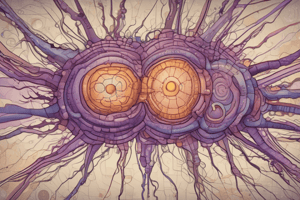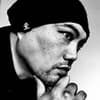Podcast
Questions and Answers
What is the function of the posterior horns in the spinal cord?
What is the function of the posterior horns in the spinal cord?
- Regulation of posture
- Motor function
- Regulation of muscle tone
- Sensory function (correct)
What is the role of the intermediolateral horns in the spinal cord?
What is the role of the intermediolateral horns in the spinal cord?
- Sympathetic and parasympathetic efferent (correct)
- Motor function
- Sensory function
- Regulation of muscle tone
What is the function of the basal ganglia in the motor system?
What is the function of the basal ganglia in the motor system?
- Regulation of muscle tone
- Regulation of postural reflexes
- Regulation of voluntary motor activity
- Initiation of movements (correct)
What is the term for neurons that transmit signals from the anterior horn cells to muscles?
What is the term for neurons that transmit signals from the anterior horn cells to muscles?
What is the term for neurons that transmit signals from the cerebral cortex to the spinal cord?
What is the term for neurons that transmit signals from the cerebral cortex to the spinal cord?
What is the role of the anterior horn cells in the spinal cord?
What is the role of the anterior horn cells in the spinal cord?
Study Notes
Definities e Mechanismos Cellular de Generation de Crise
- Epilepsia es un gruppo de desordines neural que affecta circa 1% de la population mundial.
Classification Clinical de Epilepsia
- Acute symptomatic causes:
- Fluidos e electrolytos: Na+, Ca+, Mg+
- Disordines metabolic: coma diabetico, coma hipoglicemic, uremia, hipotiroidismo, alkalosis, deficiente de B6
- Medicamentos e toxinios
- Stroke e lesions cerebral
- Infectiones del sistema nervous central (CNS)
- Remote symptomatic causes:
- Lesiones cerebral traumatic
- Infectiones del CNS
- Tumoros cerebral
- Vascular malformations
Medicamentos que Pode Causar Crises
- Antibioticos: penicilinas, cefalosporinas, quinolonas, amphotericina, fluconazol, isoniazida, zidovudina
- Medicamentos cardiovascular: lignocaina (intravenosa), procaina
- Antidepressivos: antidepressivos triciclicos, litio, fenotiazinas, baclofeno, clozapina
- Antipsychoticos: cocaina, amantadina, antimuscarinicos
- Altres medicamentos CNS: metilfenidato, aminofillina, cafeina, teofillina
Factores de Precipitation
- Reflexly inducido: epilepsy photosensible
- Factores no specifics:
- Deprivation de sono
- Stress psicologic
- Ante menstruation
- Medicamentos estrogen
- Hipoglicemia
- Deficiente de B6
- Medicamentos psicotropic
- Desbalance electrolytic
Predictors de Mal Outcome (intractabilidad)
- Edad de inicio precoce
- Frequencia alta de crises
- Presencia de lesiones cerebral
- Mal resposta a tratamento
Caracteristicas Clinicas de Epilepsia
- (i) Crises partial
- Simple partial seizures
- Complex partial seizure (TLE, psychomotor)
- Partial seizure 2ry generalized
- (ii) Crises generalized
- Petit mal
- Grand mal
- Tonic seizure
- Clonic seizure
- Tonic clonic seizure
- Atonic seizure
- Myoclonic seizure
- (iii) Sindicatos de Crises Special
- Convulsiones febrils
- Spasmos infantiles (sindrome de West)
Anatomical Features of the Nervous System
- Le systema nervosa ha duo divisiones principal: le Systema Nervosa Central (SNC) e le Systema Nervosa Peripheric (SNP)
- Le SNC es le cerebro e le medulla spinal, ambe encapsulate in ossa (cranio e columna vertebral) con coverturas protective (meninges) e spatios de fluido (CSF)
Le Cerebro
- Le cerebro es circa 2% del peso total del corpore, contenente miliardos de neuronas (cellulas nervosas)
- Le cerebro es dividite in tres partes: cerebro, tronco cerebral, e cerebello
- Le cortex cerebral es dividite functionalmente e anatomicamente in lobes e areas de function specific
Le Cortex Cerebral
- Le lobo frontal: concernite se con le control del movements, contiene areas de motor, premotor, centro de parla, e areas de movimento oculare volontari
- Le lobo parietal: concernite se con le sensation, contiene areas de sensation cortical
- Le lobo temporal: concernite se con le audition, contiene areas de audition cortical
- Le lobo occipital: concernite se con le vision, contiene areas de vision cortical
Le Tronco Cerebral
- Le tronco cerebral consiste de tres partes: mesencephalo, ponte, e medulla
- Contiene structuras importante como nuclei de nervos cranial, substantia nigra, nucleus rubro, e formation reticular
- Le tronco cerebral es importante pro le control del movements, le somn, le conscientia, e le memoria
Le Cerebello
- Le cerebello es dividite anatomicamente in duo hemisferios que son connectite per le vermis
- Le cerebello es dividite functionalmente in tres divisiones: arcierebello (concernite se con le equilibrium), paleocerebello (concernite se con le tono muscular), e neocerebello (concernite se con le coordination de movements fines)
Le Medulla Spinal
- Le medulla spinal es un structura elongate, circa 42-45 cm longe in adultos
- Le medulla spinal es dividite in 31 segments, con duo enlargementos cervical e lumbar
- Le grey matter del medulla spinal consiste de 2 cornos posteriori "sensory" e 2 cornos anteriori "motor", con horns intermediolateral in le regiones thoracic e sacral
Le Systema Nervosa Peripheric
- Le SNP consiste de nervos cranial con lor nuclei, cellulas de hornero anterior (AHC), nervos spinal, nervos peripheric, junturas neuromuscular, e musculos
Organisation del Movimentos in le Systema Motor
- Le corticospinal tracto "tracto pyramidal, upper motor neuron"
- Le ganglios basal
- Le cerebello
- Le lower motor neuron
- Lesiones in le basal ganglia → akinesia o bradykinesia
- Lesiones in le cerebello → unsteady, hypotonia, ataxic movements
Studying That Suits You
Use AI to generate personalized quizzes and flashcards to suit your learning preferences.
Description
Dr. Mahmoud Abdelhafiz's lecture on neurology, focusing on the cellular mechanisms of seizure generation, clinical classification, etiology, and acute symptomatic causes of epilepsy.




